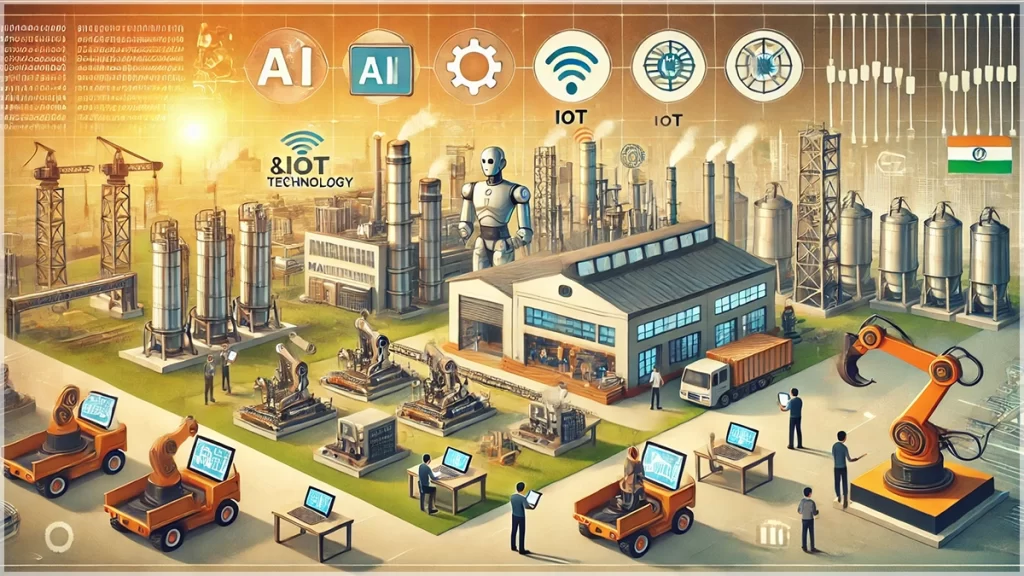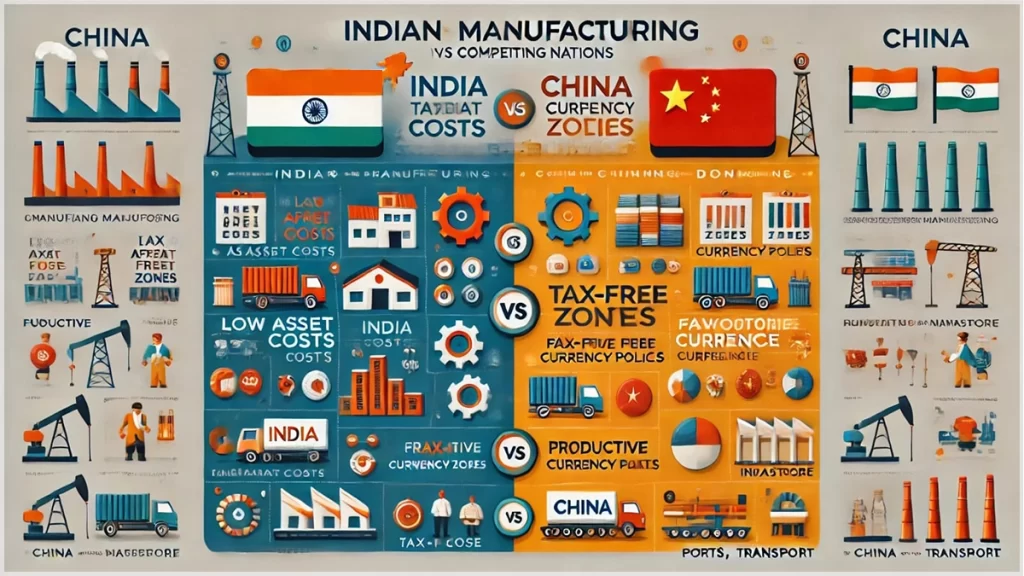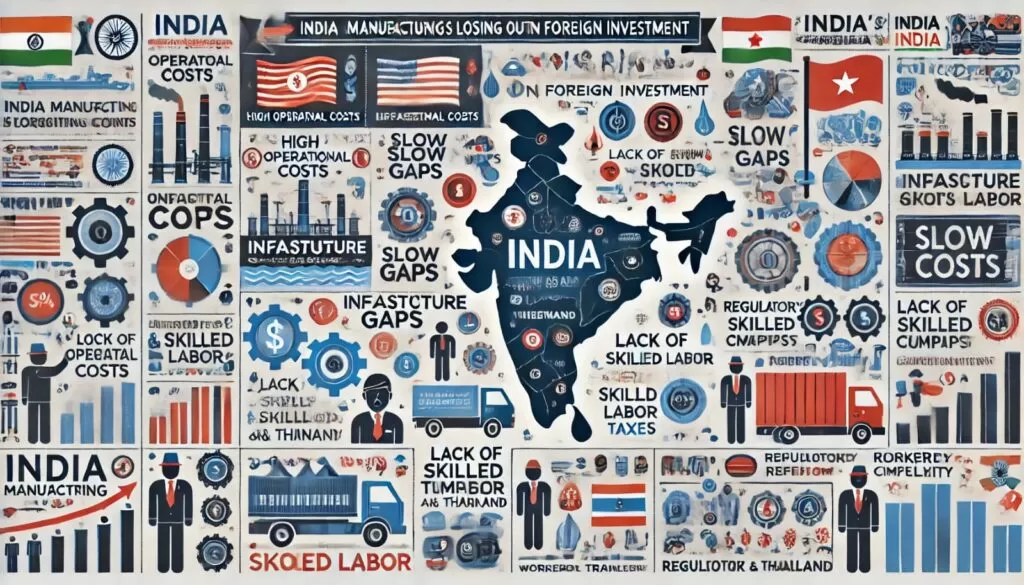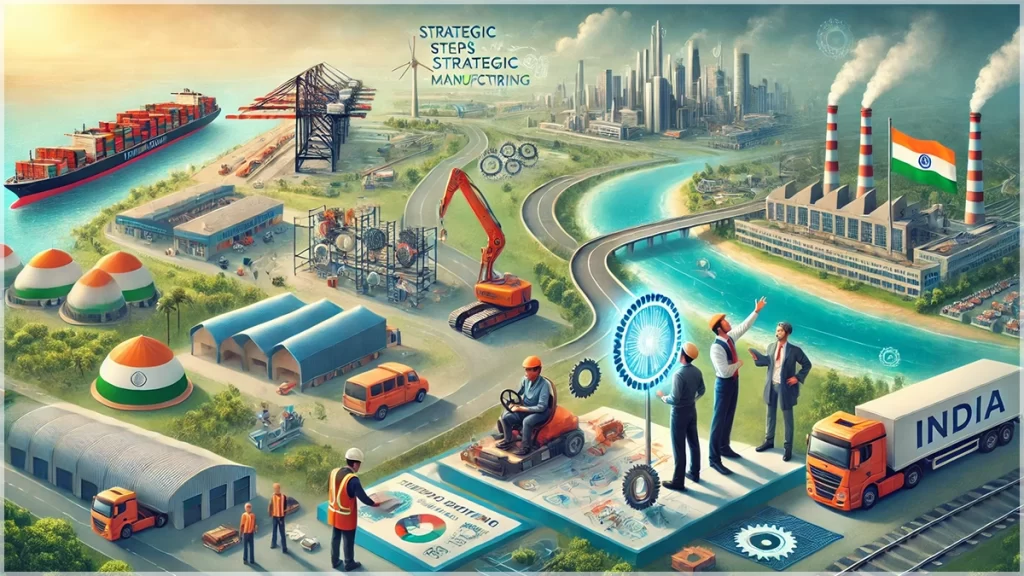Indian manufacturing plays a vital role in the country’s economy, supporting GDP growth and creating millions of jobs. This sector includes 17 significant areas such as automotive, chemicals, pharmaceuticals, and consumer durables. Indian manufacturing has a big impact on the economy, and with over 27 million people employed directly, it’s a key force for job creation. However, despite its potential, India has yet to become a global manufacturing hub, facing competition from smaller countries like Vietnam. Here, we explore India’s manufacturing sector, its strengths and weaknesses, and the steps needed to make India a leader in the global manufacturing industry.
Table of Contents
1. Current State of Indian Manufacturing

Manufacturing in India is a large and varied industry, comprising 17 major sectors. These include:
- Automotive manufacturing: India is among the top car producers worldwide.
- Pharmaceutical manufacturing: Known as the “pharmacy of the world,” India exports medicines to over 200 countries.
- Chemical and consumer goods manufacturing: Growing rapidly due to domestic and export demand.
India’s manufacturing sector is essential for the economy, contributing to GDP and job growth. However, Manufacturing in Inida is still evolving, with a government aim to export $1 trillion worth of goods by 2030. Yet, smaller nations like Vietnam are now becoming strong manufacturing hubs, attracting foreign companies at India’s expense.
2. Technological Advancements in India’s Manufacturing Sector

India’s manufacturing sector is gradually integrating automation and AI to enhance production efficiency and lower costs. As global manufacturing becomes more competitive, Indian manufacturing relies increasingly on:
- Artificial Intelligence (AI): To improve predictive maintenance, quality control, and boost productivity.
- Robotics: Helping Indian manufacturing companies with high-precision, repetitive tasks.
- Internet of Things (IoT): Tracking production processes and logistics.
While these technologies are promising, Indian manufacturing needs further support in infrastructure and policy to match up to global standards.
3. Key Challenges Facing India’s Manufacturing Sector
Indian manufacturing faces obstacles that prevent it from attracting major foreign direct investment (FDI) and growing into a global manufacturing leader. The main challenges are in areas of labor, infrastructure, and regulatory hurdles.
a. Labor and Education in Indian Manufacturing
India’s manufacturing labor, though large, often lacks the skills needed for modern production techniques. A shortage of skilled labor makes it difficult for companies to find trained workers, which countries like Vietnam and Thailand offer more readily. Indian manufacturing could benefit from better education and vocational training to meet industry needs. The Human Capital Index for 2020 places India behind nations like Vietnam, showing a need for improvements in education and healthcare for workforce readiness.
b. Infrastructure in Indian Manufacturing
India’s infrastructure still requires significant improvement to support manufacturing growth. Ports, roads, and power supply all need upgrades to keep Indian manufacturing competitive. For example, Vietnam has invested about 6.6% of its GDP into infrastructure, while India’s investment stands at around 3.3%. This difference places India at a disadvantage, though recent government initiatives are increasing funding and focus on infrastructure development for Indian manufacturing.
c. Ease of Doing Business and Regulatory Challenges
Despite ranking 63rd on the World Bank’s Ease of Doing Business Index, Indian manufacturing often faces delays due to regulatory and bureaucratic processes. The complexity of obtaining business permits, securing basic utilities, and navigating tax regulations make it challenging for companies. Countries like Vietnam, with streamlined processes, offer companies a faster and easier setup. To attract more FDI and grow India’s manufacturing sector, simplifying business regulations and reducing red tape will be crucial.
4. Indian Manufacturing vs. Competing Nations

a. China’s Manufacturing Dominance
For decades, China has led in global manufacturing, attracting companies with low asset costs, tax-free zones, and favorable currency policies. China’s education and healthcare standards have also produced a productive workforce that supports its manufacturing sector. Reliable infrastructure, including efficient ports and transport systems, has allowed China manufacturing to grow seamlessly.
b. Vietnam’s Manufacturing Growth
Vietnam manufacturing has emerged as a strong competitor, benefiting from the global manufacturing shift away from China. Vietnam’s policies, such as tax breaks, lower import duties, and streamlined processes, attract multinational companies. Its geographic location near China also lowers relocation costs for foreign companies, giving Vietnam an edge over India in the manufacturing race.
5. Reasons Indian Manufacturing is Losing Out on Foreign Investment

From 2018 to 2019, 56 companies left China, but only three chose India as a manufacturing destination, with most moving to Vietnam or Thailand. The reasons foreign companies prefer other Asian countries over India include:
- High Operational Costs: Taxes on fuel, import duties, and overall expenses in Indian manufacturing make operations more costly compared to neighboring countries.
- Infrastructure Gaps: Vietnam and Thailand offer faster logistics, efficient ports, and stronger transportation systems, making manufacturing more seamless.
- Lack of Skilled Labor: India’s manufacturing labor force lacks training compared to more established players like Vietnam.
- Regulatory Complexity: Companies face delays in India’s complex regulatory environment, whereas countries like Vietnam offer more straightforward approval processes.
The Indian government has begun reforms to improve these areas. However, faster action is needed to attract significant foreign direct investment and help India become a global leader in manufacturing.
6. Strategic Steps to Boost Indian Manufacturing

Indian manufacturing has the potential to grow as a global manufacturing hub if it focuses on strategies that address the root challenges. Key recommendations include:
a. Skill Development and Education
Improving education and investing in vocational training are essential for India’s workforce to meet the demands of modern manufacturing. Programs like Pradhan Mantri Kaushal Vikas Yojana (PMKVY) are valuable, but additional efforts are required to align the skills of India’s workers with industry standards.
b. Infrastructure Upgrades
The Indian government has introduced the National Infrastructure Pipeline, which will invest Rs 143 lakh crore by 2025. Better roads, ports, and reliable electricity will help Indian manufacturing attract more FDI and compete globally. High-quality infrastructure reduces costly delays, making Indian manufacturing more efficient.
c. Simplifying Business Regulations
Streamlining the regulatory process, including single-window clearance, would enhance ease of doing business for foreign investors. A centralized system for approvals, similar to Vietnam, could save companies time and resources when establishing operations in India.
d. Lower Import Duties and Fuel Taxes
Reducing import duties and fuel taxes for essential manufacturing inputs would reduce costs, making Indian manufacturing competitive with other Asian nations. High fuel taxes currently increase logistics expenses, making it more costly to transport goods across India.
e. Encouraging High-Tech Manufacturing
Offering incentives for advanced technology sectors, like semiconductors, pharmaceuticals, and electronics, would attract specialized companies. Sustainable manufacturing incentives could also position India as an eco-friendly manufacturing hub.
7. Indian Manufacturing Vision for 2030
Indian manufacturing has set an ambitious target of reaching $1 trillion in exports by 2030. Achieving this goal will require significant improvements in infrastructure, policy reforms, and a skilled workforce. With a clear focus on modernization and efficiency, Indian manufacturing can transform into a global powerhouse, contributing to economic growth, job creation, and technological innovation.
Conclusion
Indian manufacturing is at a critical stage. With large opportunities in export and job creation, India can become a global manufacturing leader if it addresses its infrastructure, labor, and regulatory challenges. Despite competition from Vietnam, Thailand, and other Asian countries, India has the potential to attract more foreign investment by enhancing its ease of doing business, infrastructure, and workforce skills. With consistent efforts and strategic reforms, Indian manufacturing can emerge as a competitive force in the global manufacturing industry by 2030.
Read also: BRICS Summit – 2024 Breakthrough: A Powerful Shift Towards Global Unity and Economic Independence


